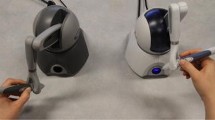Abstract
Research towards a methodology which helps designers/engineers in conceptualizing, facilitating participatory Design and validating products during designing and development process becoming more important with the aim of reducing the lengthy process and errors that crops up during the process. In this kind of situation it is felt that Virtual Reality-Haptic is among the solutions to cater repeated physical prototyping as well as for rapid prototyping and reduces related cost. This integrated system of virtual reality-Haptic feedback interaction may enhance the usability evaluation of virtual products. Therefore, emphasis of this paper is to study the virtual and augmented reality, Haptics working principles and their advantage towards product evaluation. Through this study it was possible to understand the working principles of Haptic device and write codes/program using OpenHaptics Software development Toolkit in order to manipulate the virtual object which was prepared through CAD Software (in this research CATIA was used), thereafter, experimental setup with full system were established. After preparing questionnaires and virtual reality-haptic system, participants were allowed to manipulate the virtual object via phantom Omni haptic feedback device and compare the physical properties of different virtual objects. Finally collected data were analyzed and drawn a result that revealed the potential of Virtual Reality-Haptic system for realizing the virtual objects surface texture, size, shape, and weight.




















Similar content being viewed by others
References
Tangram Technology Ltd.: http://www.tangram.co.uk/GI-Costs-3.html. Accessed (February 27, 2014)
Chen, Y.H., Yang, Z.Y., Lian, L.L.: On the development of a haptic system for rapid product development. Comput. Aided Des. 37, 559569 (2005)
Falcão, C.S., Soares, M.M.: Application of virtual reality technologies in consumer product usability. In: Design, User Experience, and Usability. Web, Mobile, and Product Design. Springer, Berlin Heidelberg, pp. 342–351 (2013)
Gao, Z., Wang, J., Jiang, Z.: Haptic perception evaluation for the virtual prototyping of elastic hand-held product designs. Vir. Phys. Prototyp. 7(2), 117–128 (2012)
Seth, A., Su, H.J., Vance, J.M.: A desktop networked haptic VR interface for mechanical assembly. In: ASME 2005 international mechanical engineering congress and exposition. pp 173–180 (2005 January)
Ye, J., Badiyani, S., Raja, V., Schlegel, T.: Applications of virtual reality in product design evaluation. In: Human-Computer Interaction. HCI Applications and Services. Springer, Berlin Heidelberg, pp. 1190–1199 (2007)
Wang, Z., Dumont, G.: Haptic manipulation of deformable CAD parts with a two-stage method. Int. J. Interact. Des. Manuf. (IJIDeM) 5(4), 255–270 (2011)
Abulrub, A.G., Attridge, Alex N., Williams, Mark A.: Virtual reality in engineering education: The future of creative learning. Global engineering education conference (EDUCON), pp. 751–757 (2011)
Etheredge, C.E., Kunst, E.E., Sanders, A.J.B.: Harnessing the GPU for Real-time haptic tissue simulation. jcgt.org 22(2), 28–54 (2013)
Gosselin, F., Bouchigny, S., Mégard, C., Taha, F., Delcampe, P., d’Hauthuille, C.: Haptic systems for training sensorimotor skills: a use case in surgery. Robot. Autonom. Syst. 61(4), 380–389 (2013)
Lele, A.: Virtual reality and its military utility. J. Ambient Intell. Hum. Comput. 4(1), 17–26 (2013)
Parsons, T.D., Trost, Z.: Virtual reality graded exposure therapy as treatment for pain-related fear and disability in chronic pain. In: Virtual, augmented reality and serious games for healthcare vol 1. Springer, Berlin Heidelberg. pp. 523–546 (2014)
Weidlich, D., Cser, L., Polzin, T., Cristiano, D., Zickner, H.: Virtual reality approaches for immersive design. Int. J. Interact. Des. Manuf. (IJIDeM) 3(2), 103–108 (2009)
Okechukwu, M.O., Ezeani, I., Okonkwo, O.R.: A survey of some virtual reality tools and resources. In: Virtual Reality and Environments, CS Lányi (Ed.). InTech (2012)
Sherman, W.R., Craig, A.B.: Understanding Virtual Reality: Interface, Application and Design. Elsevier, Amsterdam (2002)
Fallman, D., Backman, A., Holmlund, K.: VR in education: an introduction to multisensory constructivist learning environments. In: Conference on University Pedagogy. Umea University, Sweden (1999)
Ingrassia, T., Cappello, F.: VirDe: a new virtual reality design approach. Int. J. Interact. Des. Manuf. (IJIDeM) 3(1), 1–11 (2009)
Virtual reality at Ford Motor Company: http://www.automationworld.com/simulation-amp-modeling/ford-uses-virtual-reality-reduce-costs. Accessed (October 10, 2014)
Kesim, M., Ozarslan, Y.: Augmented reality in education: current technologies and the potential for education. Proc. Soc. Behav. Sci. 47(222), 297–302 (2012)
AR media Augmented Reality Blog: http://arblog.inglobetechnologies.com/?p=446. Accessed (October 10, 2014)
BMW Augmented Reality in practice: http://www.bmw.com/com/en/owners/service/augmented_reality_workshop_1.html. Accessed (October 10, 2014)
El Saddik, A., Orozco, M., Eid, M., Cha, J.: Haptics: general principles. In :Haptics Technologies. Springer, Berlin Heidelberg, pp. 1–20 (2011)
Salisbury, K., Conti, F., Barbagli, F.: Haptic rendering: introductory concepts. IEEE Comput. Graph. Appl. 24(2), 24–32 (2004)
Pontonnier, C., Dumont, G., Samani, F., Madeleine, P., Badawi, M.: Designing and evaluating a workstation in real and virtual environment: toward virtual reality based ergonomic design sessions. J. Multimodal User Interf. 2, 1–10 (2014)
Srinivasan, M.A.: What is haptics?, Laboratory for Human and Machine Haptics: The Touch Lab, Massachusetts Institute of Technology (1995)
Phantom Omni Device Guide-Geomagic, 3D Systems Corporation (2013)
Chen, C.J., Ong, S.K., Nee, A.Y.C., Zhou, Y.Q.: Haptic-based interactive path planning for a virtual robot arm. Int. J. Interact. Des. Manuf. (IJIDeM) 4(2), 113–123 (2010)
Field, A.: Discovering Statistics using SPSS. Sage publications, California (2009)
Author information
Authors and Affiliations
Corresponding author
Rights and permissions
About this article
Cite this article
Teklemariam, H.G., Das, A.K. A case study of phantom omni force feedback device for virtual product design. Int J Interact Des Manuf 11, 881–892 (2017). https://doi.org/10.1007/s12008-015-0274-3
Received:
Accepted:
Published:
Issue Date:
DOI: https://doi.org/10.1007/s12008-015-0274-3




